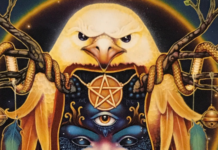
The 8 of Swords and I have a long history. It’s shown up in so many of my readings that for a long time I was surprised if it wasn’t there. But lately, as my life has changed (thankfully for the better!) I haven’t seen it as much, and in a way I’ve come to miss it, even though it always signified struggle and hardship for me. I’ve developed a close relationship with the 8 of Swords, and my own web of interpretations and associations, and now that the card stepping out of my life I feel compelled to share them.
The 8 of Swords, in the Rider-Waite-Smith deck and in most of its other incarnations, depicts a woman, bound and blindfolded, standing in a field of swords which seem to cage her in. She wears a red dress and has dark hair — an interesting contrast to the archetypal blonde damsel in a white gown. Perhaps her life has been marked more by passion than purity. There are puddles of water near her feet (which make me think of a flood plain, perhaps adding an additional danger) and behind her is a mountain with a castle-like structure on it.
In the traditional interpretation, the 8 of Swords is a card of helplessness and powerlessness, a sign of being bound by bad circumstances, toxic people, and flawed thinking. I’ve heard it called the card of “damned if you do, damned if you don’t.” That makes sense — the woman’s choice is to cut herself on the swords or remain blindfolded and bound. But beyond that, there are many, many differences in interpretation.
Tarot cards have an amazing power to evoke a personal response, but this seems particularly true with the 8 of Swords. Feeling trapped and helpless is a universal experience, one that many people don’t like to acknowledge, and so being confronted with that imagery seems to dredge up one’s past in interesting ways. Just to give one example, I’ve seen the castle on the hill described as a place of security that the woman has wandered from and must return to,1 whereas I’ve always viewed it as a prison, a place she is escaping from.
The woman’s facial expression is difficult to read because of the blindfold, but how you see it can change the entire meaning of the card. To me she looks like she’s half-smiling, somewhere between serene and cheeky. She doesn’t seem lost; she seems assured of where she is going, trusting whatever guidance she’s relied upon so far. Perhaps she takes a sort of masochistic pride in having endured so much already. Sometimes I wonder if she’s intentionally kept on the ropes and blindfolds, to cut out distractions, and to keep her focus on her goal.
The card also evokes traditional depictions of Justice, but a powerless, imbalanced version. She is blind, as Justice should be, but the swords are out of her hands; five on one side, three on the other, and no scale in sight. This factors into my readings as well; sometimes I see her as Justice disempowered, sometimes as a woman on the verge of transcending her humanity and becoming Justice itself.
I am reminded of my own experiences with trauma and mental illness2 — the feeling of still being bound despite being away from the bad situation, and the effort and pain I’ve gone through to free myself. She is perhaps not as helpless as she might think, considering she managed to escape from her tower and climb down a mountain without using her eyes or hands. I think she’ll be impressed with herself when she takes off the blindfold and sees how far she’s come.
I’m fascinated with mythology and folklore. I often see my life playing out in fairy tale motifs, and here is no different. The 8 of Swords always makes me think of a particular scene in the Grimm story “The Girl Without Hands.“3 The story starts when a poor man is tricked into selling his daughter to the Devil in exchange for wealth. On the day the Devil came to take her, he could not touch her because she was pious and clean. Her ordered her father to take all water away from her so she couldn’t wash, and out of fear he did. On the second day, the Devil came back, and the girl had wept on her hands so they were absolutely clean. The Devil told the girl’s father to chop off her hands, and he did. By the third day, the girl had wept so much on her bloody stumps that they were perfectly clean, and the Devil had to relinquish his claim on her.
The girl’s father tells her that, since he has all this wealth he gained from the Devil, he could care for her and she could live well for the rest of her life. What she says and does after sets the theme for the rest of the story, and is the moment I see on the card:
“Here I cannot stay, I will go forth; compassionate people will give me as much as I need.“ Thereupon she caused her maimed arms to be bound to her back, and by sunrise she set out on her way.
That is where I see the woman on the 8 of Swords; leaving her prison and going forth, trusting the universe to guide her. She could have stayed in that castle and lived well in the material sense, but at the cost of her dignity, being cared for with the Devil’s money by the person who mutilated her. It’s worth noting that, in some versions of the story,4 the Devil isn’t even involved, and the girl is fleeing unwanted sexual advances from her father or brother. In some cases, she even cut off her own hands in a desperate effort to make herself unattractive. That adds another interesting layer to the card: was the woman bound by others, and why? If she bound herself, did she fear her own potential, or was she afraid of being exploited?
For the rest of the tale, the girl, after forsaking her mortal attachments, gains protection from heaven. Angels appear to her often; they guide her first to a castle, where a king falls in love with her, has silver hands made for her, and eventually marries her. Later, after the Devil tricks her into thinking the king wishes to kill her, they guide her to a house in the wilderness “where all dwell free.” She lives there in contemplation for seven years, and because of her piety, her hands grow back.
But there’s no way to know for sure where the woman on the 8 of Swords is in her story; her arms are bound behind her back, and I can’t see if she has hands of flesh, hands of silver, or no hands at all. I see her in different places depending on the cards around her and where I am in my own story. Only one thing is clear: To cut her bonds, she must cut herself as well. She may even put her hands at risk again, but she must feel her pain fully. (And besides, hands grow back.) More importantly, she can never stop walking. She’s come too far to turn back now.
Questions to consider when the 8 of Swords appears
Think about the traditional meanings: are you feeling helpless or powerless? Are you in a “damned if you do, damned if you don’t” situation?
Did you bind yourself? Was it out of self-sabotage, or a need to cut out distractions? Do you feel pressed for time? (Are you afraid the plain will flood before you’ve completed your journey?)
Do you feel lost, or sure of where you’re going? Who’s or what’s guidance are you following? How do you view the structure in the background? Is it a prison, a place of security, or something else? How does that affect your view of the card?
Is Justice being served? Have you tried to take Justice into your own hands? (If the 8 of Swords shows up in the same spread as Justice, pay close attention to how they interact.)
Do you need to step away from material attachments, or spend some time in contemplation?
- Learn Tarot, “Eight of Swords.” [↩]
- See also, “Pomegranate and trauma: Delving into the Underworld.” [↩]
- Tracy Arah Dockray, “The Girl Without Hands,” in Grimm’s Grimmest, p 90-97. [↩]
- See, “Tales Similar to Girl Without Hands.” [↩]








